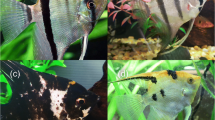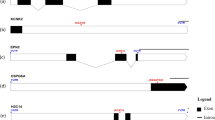Abstract
Six polymorphic microsatellite DNA loci were identified in the primitive fish, bronze featherback, Notopterus notopterus for the first time and demonstrated significant population genetic structure. Out of the six primers, one primer (NN90) was specific to N. notopterus (microsatellite sequence within the RAG1 gene) and five primers were product of successful cross-species amplification. Sixty-four primers available from 3 fish species of order Osteoglossiformes and families Notopteridae and Osteoglossidae were tested to amplify homologous microsatellite loci in N. notopterus. Fifteen primer pairs exhibited successful cross-priming PCR product. However, polymorphism was detected only at five loci. To assess the significance of these six loci (including NN90) in population genetic study, 215 samples of N. notopterus from five rivers, viz Satluj, Gomti, Yamuna, Brahmaputra and Mahanadi were analyzed. The five sample sets displayed different diversity levels and observed heterozygosity ranged from 0.6036 to 0.7373. Significant genotype heterogeneity (P < 0.0001) and high FST (0.2205) over all loci indicated that the samples are not drawn from the same genepool. The identified microsatellite loci are promising for use in fine-scale population structure analysis of N. notopterus.
Similar content being viewed by others
References
O’Connell M, Wright JM (1997) Microsatellite DNA in fishes. Rev Fish Biol Fish 7:331–363
Neff BD, Gross MR (2001) Microsatellite evolution in vertebrates: inference from AC dinucleotide repeats. Evolution 55:1717–1733
Chistiakov DA, Hellemans B, Volckaert FAM (2006) Microsatellites and their genomic distribution, evolution, function and applications: a review with special reference to fish genetics. Aquaculture 255:1–29
Scribner KT, Pearce JM (2000) Microsatellites evolutionary and methodological background and empirical applications at individual, population, and phylogenetic levels. In: Baker A (ed) Molecular methods in ecology. Blackwell Science Ltd., London, pp 235–271
Primmer CR, Moller AP, Ellegren H (1996) A wide-range survey of cross-species microsatellite amplification in birds. Mol Ecol 5:365–378
Palo JU, Ma¨kinen HS, Helle E, Stenman O and Va¨ino¨ la¨ R (2001) Microsatellite variation in ringed seals (Phocahispida): genetic structure and history of the Baltic Sea population. Heredity 86:609–617
Zardoya R, Vollmer DM, Craddock C, Streelman JT, Karl S, Meyer A (1996) Evolutionary conservation of microsatellite flanking regions and their use in resolving the phylogeny of cichlid (Pisces: Perciformes). Proc R Soc Lond B 263:1589–1598
Scribner KT, Gust JR, Fields RL (1996) Isolation and characterization of novel salmon microsatellite loci: cross species amplification and population genetics applications. Can J Fish Aqua Sci 53:833–841
Smith CT, Koop BF, Nelson RJ (1998) Isolation and characterization of coho salmon (Oncorhynchus kisutch) microsatellites and their use in other salmonids. Mol Ecol 7:1613–1621
Cairnney M, Taggart BJ, Hoyheim B (2000) Characterization of microsatellite and minisatellites loci in Atlantic salmon (Salmo salar L.) and cross-species amplification in other salmonids. Mol Ecol 9:2175–2178
Zheng W, Stacey NE, Coffin J, Strobeck C (1995) Isolation and characterization of microsatellite loci in the goldfish Carassius auratus. Mol Ecol 4:791–792
Mohindra V, Anshumala, Punia P, Narain L, Kapoor D, Lal KK (2005) Microsatellite loci to determine population structure of Labeo dero (Cyprinidae). Aquat Living Resour 18:83–85
Chaturvedi A, Mohindra V, Singh RK, Lal KK, Punia P, Bhaskar R, Mandal A, Narain L, Lakra WS (2011) Population genetic structure and phylogeography of cyprinid fish, Labeo dero (Hamilton, 1822) inferred from allozyme and microsatellite DNA marker analysis. Mol Biol Rep 38:3513–3529
Mandal A, Lal KK, Mohindra V, Singh RK, Punia P, Chauhan UK, Lakra WS (2009) Evaluation of genetic variation in the clown Knifefish, Chitala chitala, using allozymes, RAPD, and microsatellites. Biochem Genet 47:216–234
Wirth T, Saint-Laurent R, Bernatchez L (1999) Isolation and characterization of microsatellite loci in the walleye (Stizostedion vitreum), and cross-species amplification within the family Percidae. Mol Ecol 8:1960–1963
McQuown EC, Sloss BL, Sheehan RJ, Rodzen J, Tranah GJ, May B (2000) Microsatellite analysis of genetic variation in sturgeon: new primer sequences for Scaphirhynchus and Acipenser. Trans Am Fish Soc 129:1380–1388
Taverne L (1975) A propos de Tselfatia Arambourg, C., 1943 (Cénomanien du Maroc), de Protobrama (Cénomanien du Liban) et du rapport éventuel des Tselfatioïdes fossiles (Crétacé) et des Téléostéens du super-ordre des Ostéoglossomorphes. Ann Soc R Zool Belg 105(1–2):53–72
Nelson JS (1994) Fishes of the World. Wiley, New York
Otero O, Gayet M (2001) Palaeoichthyofaunas from the Lower Oligocene and Miocene of the Arabian plate, palaeoecological and palaeobiogeographical implications. Palaeogeogr Palaeoclimatol Palaeoecol 165:141–169
Talwar KP, Jhingran AG (1991) Inland fishes of India and adjacent countries. Oxford & IBH, New Delhi
Casavas I, Doulman DJ, Petr TO, Padro J, Debas L (1996) Cambodia-rehabilitation and development needs of the fishery sector. FAO, Rome
CAMP (1998) Conservation Assessment and Management Plan for freshwater fishes of India. Zoo outreach organization and NBFGR, Lucknow, p 156
Ng HH, (2010) Notopterus notopterus. In: IUCN 2012. IUCN Red List of Threatened Species. Version 2012.1. http://www.iucnredlist.org. Downloaded on 07 September 2012
Rainboth WJ (1996) Fishes of the Cambodian Mekong. FAO Species Identification Field Guide for Fishery Purposes. FAO, Rome, p 265
Takagi Akira P, Ishikawa Satoshi, Thuok Nao, Sitha Hort, Masanori Nakatani, Mutsumi Nishida, Hisashi Kurokura (2006) Tandem repeat sequence segments in control region of bronze featherback Notopterus notopterus mitochondrial DNA. Fish Sci 72(6):1319
Takagi AP, Ishikawa S, Nao T, Song SL, Hort S, Thammavong K, Saphakdy B, Phomsouvanhm A, Nishida M, Kurokura H (2010) Genetic differentiation and distribution routes of the bronze featherback Notopterus notopterus (Osteoglossiformes: Notopteridae) in Indochina. Biol J Linnean Soc 101:575–582
Lal KK, Mandal A, Singh RK, Punia P, Kapoor D, Chauhan UK, Singh SP, Mohindra V (2006) Genetic divergence in two feather back fishes, Chitala chitala and Notopterus notopterus. J Appl Ichthyol 22(5):369–373
Ruzzante DE, Taggart C, Cook D, Goddard S (1996) Genetic differentiation between inshore and offshore Atlantic cod (Gadus morhua) off Newfoundland: microsatellite DNA variation and antifreeze level. Can J Fish Aquat Sci 53:634–645
Belkhir K, Borsa P, Goudet J, Chikhi L, Bonhomme F (1997) GENETIX version 4.02, Genetics logiciel sous windows pour Ia ge’ ne’ Tique des populations, available at: http://www.univmontp2.fr/genetix/genetix.htm
Raymond M, Russet F (1998) GENEPOP Version 3.3d Population Genetics Software for Exact Test and Ecumenicism, available at: http://www.cefe.cnrs-mop.fr
Venkatesh B, Ning Y, Brenner S (1999) Late changes in spliceosomal introns define clades in vertebrate evolution. Proc Natl Acad Sci USA 96(18):10267–10271
Van Hooft WF, Hanotte O, Wenink PW, Groen AF, Sugimoto Y, Prins HH, Teale A (1999) Applicability of bovine microsatellite markers for population genetic studies on African buffalo (Syncerus caffer). Anim Genet 30:214–220
Mandal A, Mohindra V, Singh RK, Punia P, Lal KK (2011) Mitochondrial DNA variation in Indian populations of endangered Feather-Back Fish, Chitala chitala. Mol Biol Rep 39(2):1765–1775
Gopalakrishnan A, Abdul Muneer PM, Musammilu KK, Lal KK, Kapoor D, Mohindra V (2006) Primers from order Osteoglossiform and Siluriform detect polymorphic microsatellite loci in suncatfish, Horabagrus brachysoma (Teleostei: Bagridae). J Appl Ichthyol 22(5):456–458
Zhu Y, Strassmann JE, Queller DC (2000) Insertions, substitutions, and the origin of microsatellites. Genet Res 76:227–236
Lande R (1996) The meaning of quantitative genetic variation in evolution and conservation. In: Szaro RC, Johnston DW (eds) Biodiversity in managed landscapes. Oxford University Press, New York, pp 27–40
Oostermeijer JGB, Luijten SH, den Nijs JCM (2003) Integrating demographic and genetic approaches in plant conservation. Biol Conserv 113:389–398
Wright S (1965) The interpretation of population structure by Fstatistics with special regard to systems of mating. Evolution 19:395–420
Weir BS, Cockerham CC (1984) Estimating F-statistics for the analysis of population structure. Evolution 38:1358–1370
Gaut B, Le Thierry d’Ennequin M, Peek AS, Sawkins MC (2000) Maize as a model for the evolution of plant nuclear genomes. Proc Natl Acad Sci USA 97:7008–7015
Luikart G, England PR, Tallmon D, Jordan S, Taberlet P (2003) The power and promise of population genomics: from genotyping to genome typing. Nat Rev Genet 4:981–994
Ward RD, Grewe PM (1994) Appraisal of molecular genetics techniques in fisheries. Rev Fish Biol Fish 4:300–325
Hartl DL, Clark AG (1997) Principles of population genetics. Sinauer Associates Inc Publishers, Sunderland
Acknowledgments
The authors express thanks to Director, National Bureau of Fish Genetic Resources (Indian Council of Agricultural Research), Lucknow for supporting the work under institutional project,” Genetic approaches for conservation of prioritized Indian fish species,” Excellent technical assistance provided by Mr. Sree Ram is also duly acknowledged.
Author information
Authors and Affiliations
Corresponding author
Rights and permissions
About this article
Cite this article
Gupta, A., Lal, K.K., Punia, P. et al. Characterization of polymorphic microsatellite markers and genetic diversity in wild bronze featherback, Notopterus notopterus (Pallas, 1769). Mol Biol Rep 40, 6625–6631 (2013). https://doi.org/10.1007/s11033-013-2776-z
Received:
Accepted:
Published:
Issue Date:
DOI: https://doi.org/10.1007/s11033-013-2776-z




